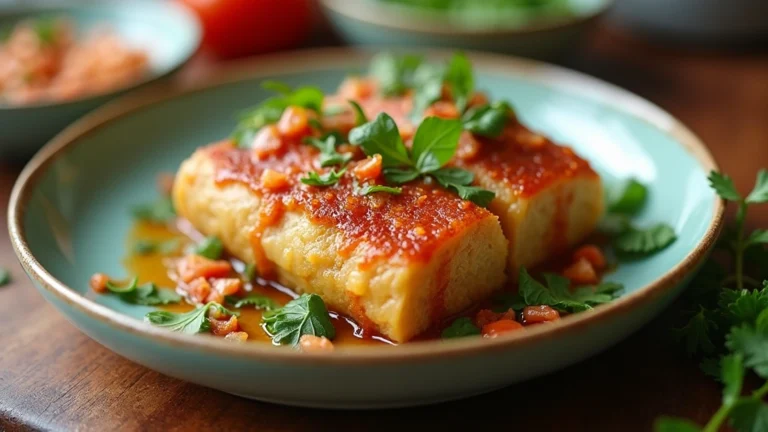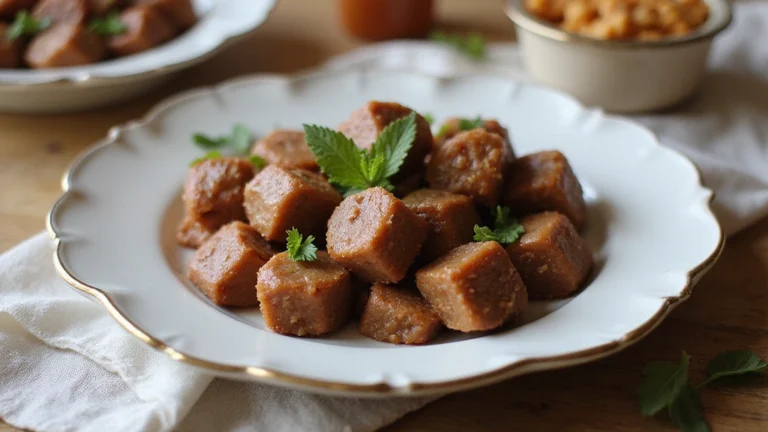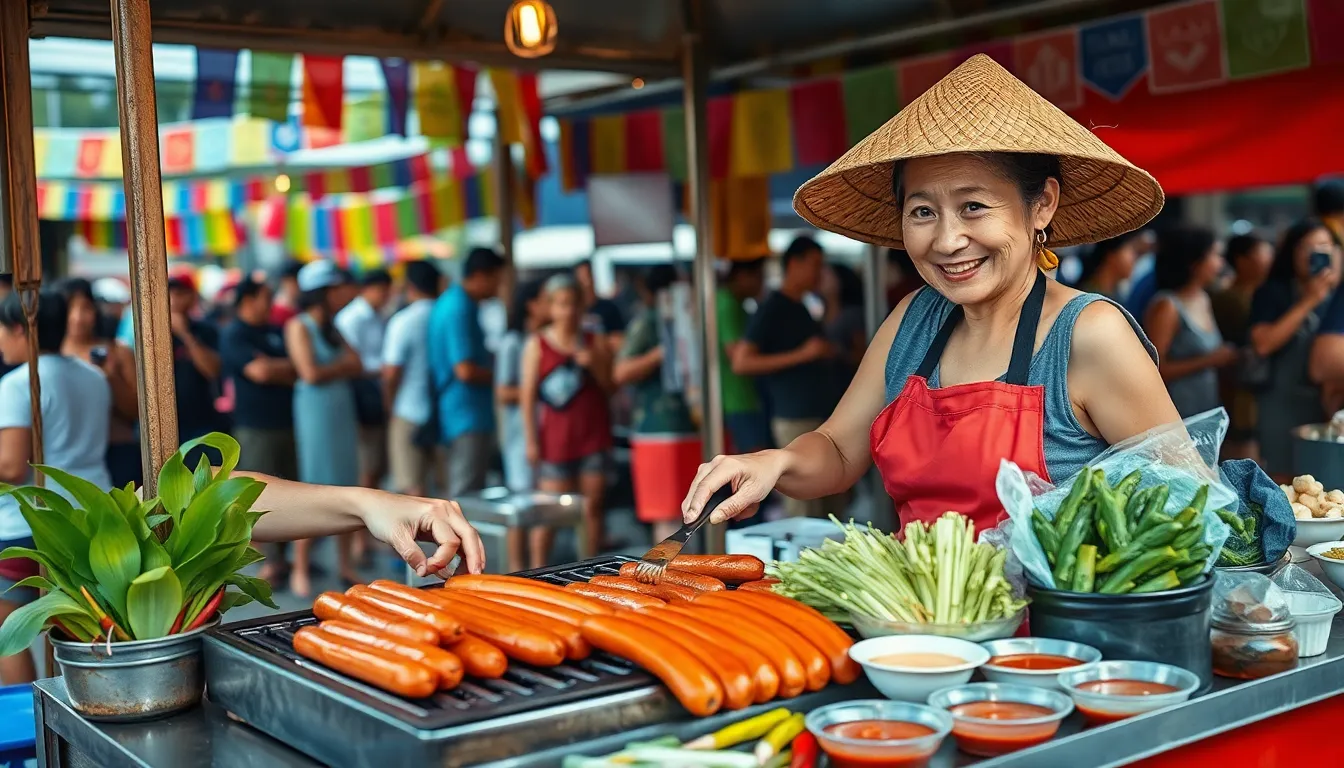
Discover the mouthwatering industry of Sai Ua, a Northern Thai sausage that’s bursting with exotic flavors. Unlike typical sausages, these Thai delicacies sing with aromatic ingredients like kaffir lime leaves, lemongrass, chili, garlic, and ginger. The long lines at Sai Ua stalls throughout Thailand are a testament to their irresistible appeal.
What makes this recipe so approachable is how simple the filling is to prepare. You’ll learn how to create these complex, herbal-rich sausages at home, with options to use traditional casings or form them into skinless patties. While this might be a bit of a project, the results are well worth the effort—and they freeze beautifully, making them perfect for batch cooking.
What Is Thai Sausage?
Thai sausage represents a diverse family of regional specialties with distinctive flavor profiles that set them apart from Western counterparts. These flavorful links are deeply embedded in Thailand’s culinary industry and offer a fascinating glimpse into the country’s regional food traditions.
Two prominent varieties dominate the Thai sausage scene:
Sai Ua – This Northern Thai specialty is a fresh sausage packed with aromatic herbs and spices. Made primarily with pork, Sai Ua incorporates a vibrant mixture of lemongrass, galangal, garlic, and makrut lime leaves, creating a complex herbal profile that’s intensely aromatic. While not fermented, its distinctive flavor comes from the generous use of fresh herbs and sometimes red curry paste.
Sai Krok Isan – Hailing from Northeastern Thailand (Isan region), this fermented sausage combines pork and rice with seasonings like garlic and salt. What makes Sai Krok Isan truly special is its traditional fermentation process – typically done under the hot sun for 6+ hours – which develops its characteristic tangy flavor. This fermentation not only creates a distinct sour note but also serves as a preservation method.
The texture of Thai sausages varies by type. Sai Ua offers a juicy herbal bite while Sai Krok Isan features a unique texture from the fermented rice grains mixed with meat.
In Thailand you’ll frequently spot these sausages sizzling on charcoal grills at street food carts where they’re enjoyed as popular on-the-go snacks by both locals and tourists. Thai sausages are typically served with accompaniments including:
- Fresh vegetables (cabbage, lettuce, cucumber)
- Bird’s eye chilies for heat
- Fresh ginger slices
- Raw garlic cloves
- Sticky rice (especially with Sai Krok Isan)
Thai sausages pair wonderfully with spicy Thai salads like som tum (papaya salad) and long bean salad, creating a balanced and authentic Thai meal experience.
Types Of Thai Sausage

Thailand’s diverse culinary industry features several distinctive regional sausage varieties each with unique preparation methods and flavor profiles. Two of the most popular Thai sausages showcase the country’s rich culinary traditions and regional specialties.
Sai Ua (Northern Thai Sausage)
Sai Ua is a flavorful aromatic grilled sausage originating from Northern Thailand known for its complex blend of herbs and spices. This fresh sausage delivers a rich curry-like taste profile that makes it instantly recognizable among Thai cuisine enthusiasts.
The secret to authentic Sai Ua lies in its aromatic ingredients:
- Lean pork shoulder (1400g) combined with pork fat (600g) for perfect juiciness
- Fresh herbs including lemongrass (320g of tender parts) makrut lime leaves (30g) and cilantro stems
- Aromatic spices including galangal garlic (240g) and turmeric root
- Seasonings like fish sauce soy sauce palm sugar (40g) and Thai shrimp paste (20g)
- Toasted red chili flakes (3 tablespoons) for subtle heat
The preparation involves mixing finely chopped herbs and spices with the ground pork before stuffing into casings. When grilled the sausage develops a crispy exterior while remaining juicy inside. The fresh herbs combined with fermented shrimp paste create the distinctive northern Thai flavor that pairs perfectly with sticky rice and fresh vegetables.
Sai Krok Isan (Northeastern Thai Sausage)
Sai Krok Isan is a fermented pork sausage from Thailand’s Northeastern region with a unique tangy flavor profile that distinguishes it from other Thai sausages. This street food staple combines pork with cooked sticky rice which facilitates the fermentation process.
The ingredient list for Sai Krok Isan is deceptively simple:
- Ground pork
- Cooked sticky rice
- Garlic
- Salt
- Optional spices and herbs for regional variations
What makes Sai Krok Isan special is the fermentation process. After stuffing the mixture into casings the sausages are left in warm conditions for several days allowing natural fermentation to develop their characteristic sour flavor. This process not only creates a distinct taste but also adds probiotic benefits.
The traditional way to enjoy Sai Krok Isan is grilled over charcoal until done with a slightly crispy exterior. Locals typically serve these sausages with fresh chilies ginger slices raw garlic and crisp vegetables like cabbage or cucumber which balance the savory and tangy flavors. The rice grains visible in each slice add a unique texture that complements the meat perfectly.
Ingredients

Creating authentic Thai sausage requires a exact blend of aromatic herbs and spices that give Sai Ua its distinctive flavor profile. The following ingredients will yield a flavorful batch of Northern Thai sausage with a complementary dipping sauce.
For The Sausage Mixture
- 1 lb (450g) ground pork (preferably with high fat content for juiciness)
- 5 kaffir lime leaves, center stems removed and finely minced
- 110g chopped cilantro stems and roots
- 3 stalks lemongrass, tender parts only, roughly chopped (about 320g)
- 200g galangal, peeled and roughly chopped
- 70g fresh turmeric root, peeled and chopped
- 200g shallots, roughly chopped
- 240g garlic cloves
- 3 tablespoons toasted red chili flakes (adjust to your heat preference)
- 40g palm sugar or light brown sugar
- 20g Thai shrimp paste (gapi)
- 20g salt
- 100g fish sauce
- Sausage casings (optional if making patties instead)
For The Dipping Sauce
- 2 tablespoons fish sauce
- 1 tablespoon lime juice
- 1 tablespoon toasted rice powder (optional for authentic texture)
- 1-2 fresh Thai chilies, finely chopped
- 1 teaspoon palm sugar
- 1 clove garlic, minced
- Fresh cilantro or green onions for garnish
- 3 kaffir lime leaves, finely chopped (optional for extra aroma)
- 2 tablespoons Thai red curry paste (optional for added depth)
Equipment Needed
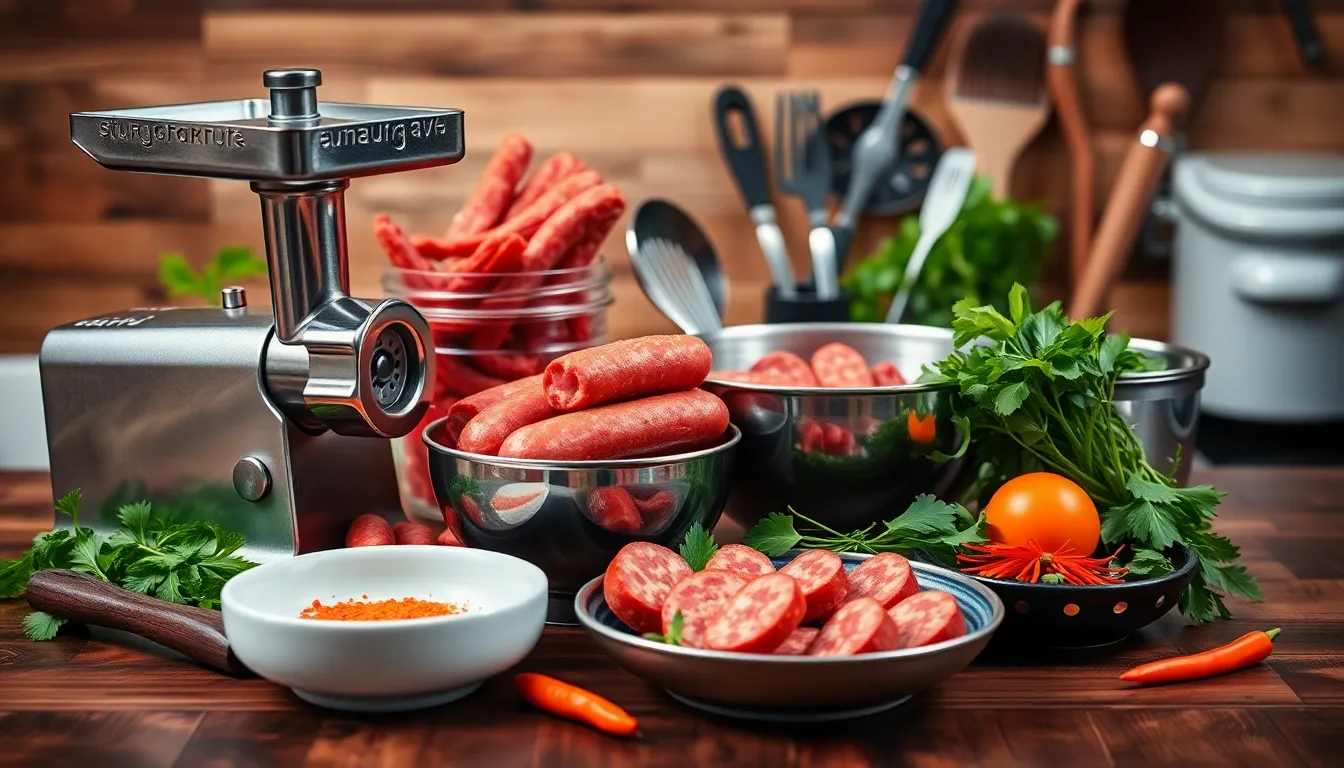
To successfully prepare authentic Thai sausage (Sai Ua) at home you’ll need several key pieces of equipment. Having the right tools on hand makes the process more efficient and helps achieve the best results.
- Meat grinder with medium-coarse grinding plate (7-8 mm holes) – This ensures the proper texture for your sausage mixture. If you don’t have a meat grinder you can purchase pre-ground pork.
- Sausage stuffer or stuffer attachment – For traditional cased sausages this tool is essential. If using a meat grinder many models come with stuffer attachments.
- Kitchen scale – For accurate measurement of ingredients ensuring balanced flavors in your Thai sausage.
- Mortar and pestle – Traditional tool for crushing herbs and spices to release their essential oils. An immersion blender or food processor can substitute but won’t release flavors quite as effectively.
- Sharp knife and cutting board – For preparing aromatics like lemongrass galangal and kaffir lime leaves.
- Mixing bowl (large) – For combining ground meat with curry paste and herbs.
- Latex or disposable gloves – Highly recommended for mixing the sausage meat to protect your hands from chili oils and for general hygiene.
- Cooking equipment – Either a broiler grill or frying pan for cooking the sausages.
- Foil-lined baking tray – If broiling your sausages this catches drippings and makes cleanup easier.
- Thermometer – Optional but helpful to ensure sausages reach a safe internal temperature of 160°F (71°C).
If you’re making Sai Krok Isan (the fermented Northeast Thai sausage) you’ll also need:
- Airtight containers – For the fermentation process.
- Cheesecloth or thin cotton cloth – For wrapping fermented sausages.
- Toothpicks or kitchen twine – For securing sausage casings.
While specialized equipment like a meat grinder and sausage stuffer will produce the most authentic results you can still create delicious Thai sausage patties without casings using just basic kitchen tools. This simplified approach makes this flavorful dish accessible to home cooks with any level of equipment.
Instructions
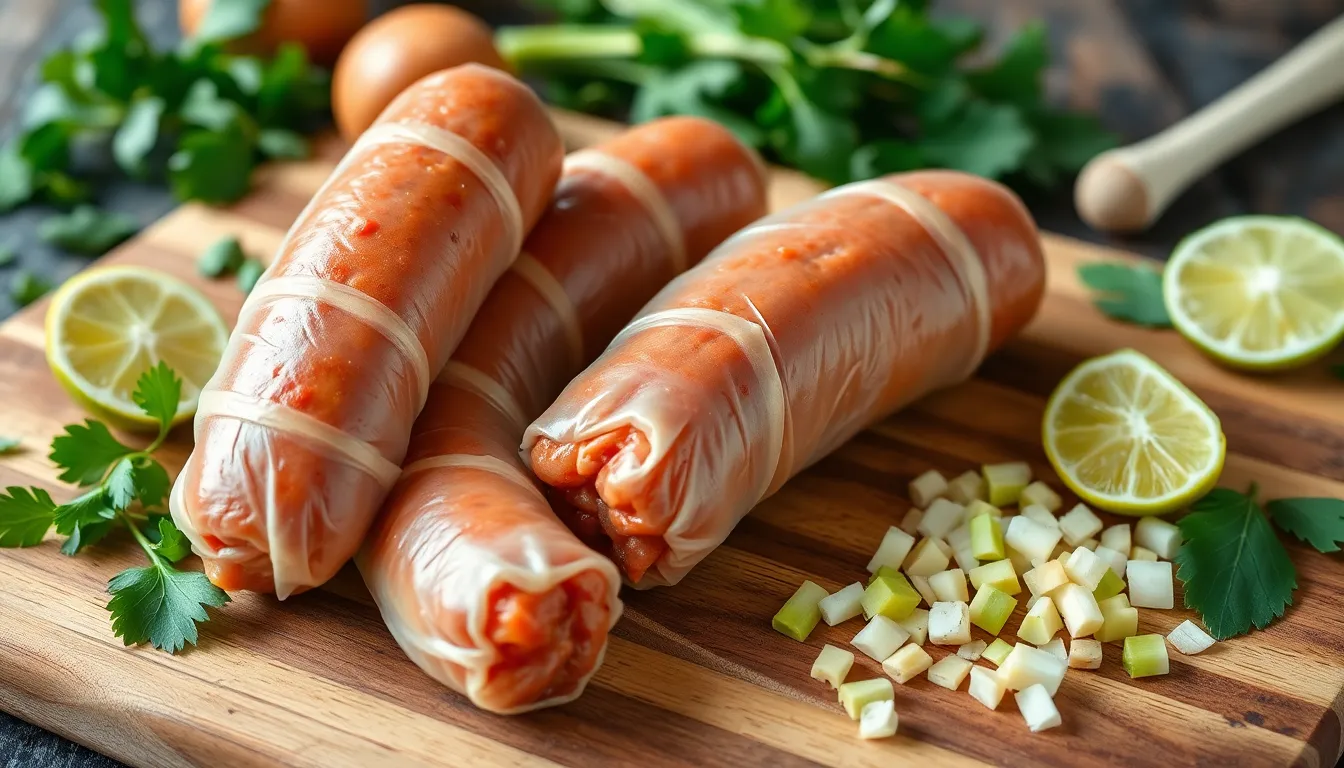
Follow these step-by-step instructions to create authentic Thai sausages that burst with aromatic flavors. Each stage of the process contributes to developing the complex taste profile that makes Thai sausages so distinctive.
Preparing The Filling
- Start with fatty ground pork for maximum flavor and juiciness.
- In a mortar and pestle crush garlic and coriander root until they form a coarse paste. This releases their essential oils and intensifies their flavors.
- Prepare the aromatic ingredients: thinly slice kaffir lime leaves mince lemongrass shallots and galangal and soak dried Thai chilies if using.
- Combine the ground pork with the crushed garlic-coriander paste and all prepared aromatics in a large mixing bowl.
- Add seasonings: fish sauce oyster sauce white pepper sugar lime juice and turmeric. If making Sai Krok Isan incorporate cooked sticky rice (approximately 100g per 200g of meat) for texture and fermentation.
- Mix thoroughly by hand until all ingredients are evenly distributed but avoid overworking the meat which can make the sausage tough.
- Cover the mixture and refrigerate for at least 4 hours or overnight to allow flavors to develop fully. This resting period is crucial for melding the complex spice profile.
Stuffing The Sausage
- Prepare natural sausage casings by soaking them in cool water for 30 minutes to make them pliable.
- Rinse casings thoroughly under running water cleaning both the inside and outside to remove any salt and impurities.
- Tie a secure knot at one end of the casing to prevent filling from escaping.
- If using a sausage stuffer load the filling into the machine ensuring there are no air pockets. For a manual method spoon the mixture into a piping bag with a wide nozzle.
- Attach the open end of the casing to the stuffer nozzle or piping bag and gently fill with the meat mixture allowing the casing to determine the thickness.
- Avoid overstuffing as the sausage needs room to expand during cooking.
- When the casing is filled tie it off at 1-2 inch intervals using kitchen string to form individual sausages.
- Use a toothpick to poke several small holes in each sausage to prevent them from bursting during cooking especially if frying.
- For Sai Krok Isan place the filled sausages in a sunny spot or open air for 6 hours to develop their characteristic tangy flavor. For extra sourness extend this fermentation period up to 24 hours.
Cooking Methods
- Grilling Method:
- Preheat a charcoal grill for the most authentic smoky flavor.
- Grill sausages over medium heat turning occasionally until the casing is browned and crispy.
- Cook until the internal temperature reaches 160°F (71°C) for safe consumption.
- This method works particularly well for both Sai Ua and Sai Krok Isan.
- Pan-Frying Method:
- Heat a lightly oiled skillet over medium heat.
- Add sausages or patties and cook until browned on all sides.
- Reduce heat to medium-low cover and continue cooking until fully done about 10-15 minutes.
- This method is ideal for skinless sausage patties.
- For Skinless Options:
- Form the filling into 2-tablespoon sized patties.
- Pan-fry in oil over medium-high heat until crispy on the outside and cooked through (165°F or 74°C internal temperature).
- This quicker method maintains the flavors while eliminating the need for casings.
- Let the cooked sausages rest for 5 minutes before serving to redistribute juices and enhance flavor.
- Serve traditionally with sticky rice fresh herbs like cilantro and crunchy vegetables such as cabbage cucumber or long beans. Include a spicy dipping sauce made from lime juice fish sauce and chilies to complete the authentic Thai experience.
Serving Suggestions
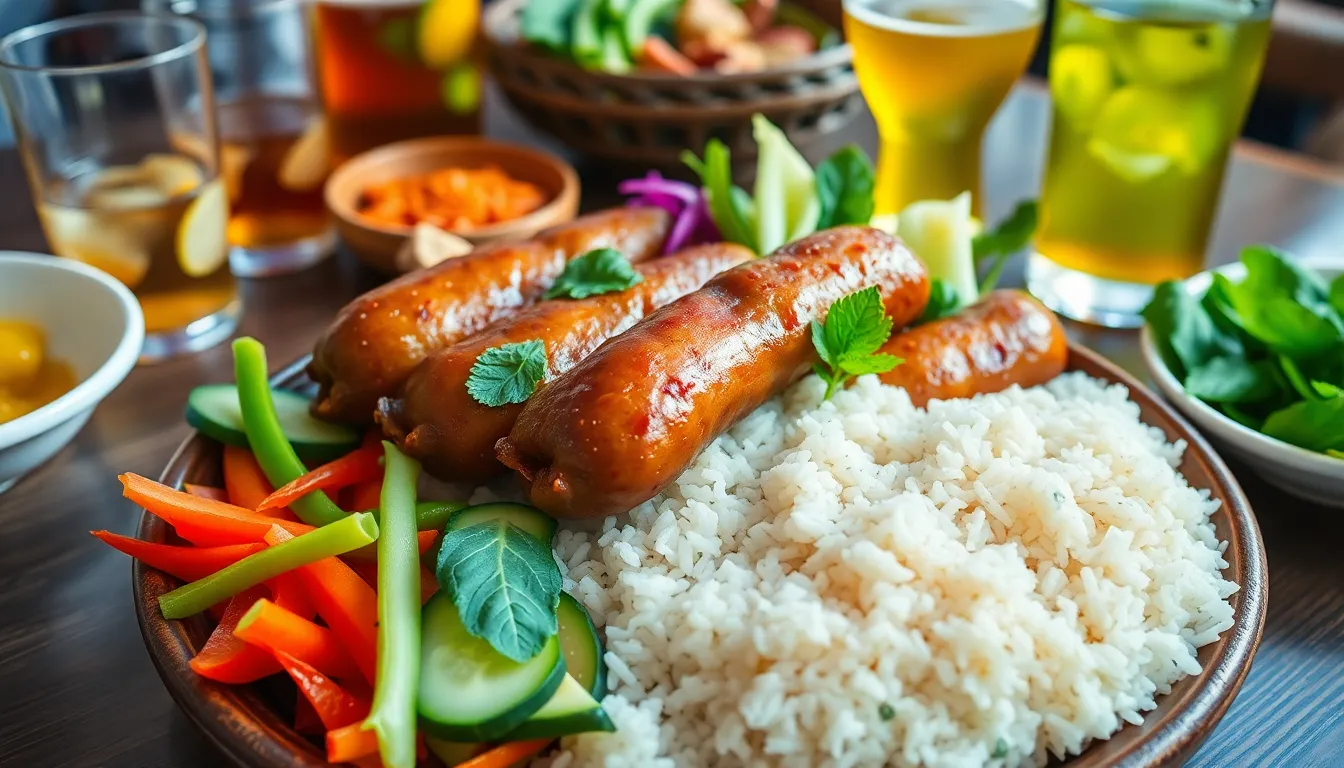
Thai sausage (Sai Ua) is traditionally served with complementary sides that enhance its bold aromatic flavors. Here are the best ways to enjoy your homemade Thai sausage for an authentic experience:
Traditional Pairings
Serve your Thai sausage with sticky rice (khao niew) which acts as the perfect neutral base to balance the sausage’s intense flavors. Simply place a slice of sausage on top of a small handful of sticky rice and enjoy them together. This combination is the quintessential Northern Thai way to appreciate Sai Ua.
Fresh vegetables are essential accompaniments that provide crunch and freshness. Arrange a platter with:
- Cucumber slices
- Cabbage wedges
- Long beans
- Thai basil
- Mint leaves
- Cilantro sprigs
These raw vegetables help cut through the richness of the sausage while adding textural contrast to your meal.
Dipping Sauces
A spicy chili-lime dipping sauce elevates the Thai sausage experience. The tangy acidity and heat complement the savory sausage perfectly. You can prepare a simple nam jim sauce by combining:
- 2 tbsp fish sauce
- 2 tbsp lime juice
- 1 tsp sugar
- 1-2 minced Thai chilies
- 1 clove minced garlic
For added complexity try nam prik noom (roasted green chili dip) or nam prik ong (tomato chili dip) both of which pair wonderfully with Sai Ua.
Meal Composition
Turn your Thai sausage into a complete meal by serving it alongside:
- Som tam (green papaya salad)
- Laab (minced meat salad)
- Nam prik num (roasted chili dip)
- Khao soi (curry noodle soup)
This combination creates a traditional Northern Thai feast known as khan toke when arranged on a low round table. Each component offers different flavors and textures that harmonize with the aromatic sausage.
Modern Serving Ideas
Beyond traditional presentations you can incorporate Thai sausage into fusion dishes:
- Slice and add to fried rice
- Include in stir-fried vegetables
- Use as a protein topping for noodle dishes
- Crumble into omelettes or scrambled eggs
- Add to homemade pizza as a gourmet topping
These creative applications maintain the sausage’s distinctive flavor profile while offering versatile meal options.
Beverage Pairings
Complete your Thai sausage meal with appropriate beverages:
- Thai iced tea
- Cold lager beer
- Coconut water
- Lemongrass tea (hot or iced)
The cooling effect of these drinks balances the warm spices in the sausage making for a well-rounded dining experience.
Storage And Freezing Tips
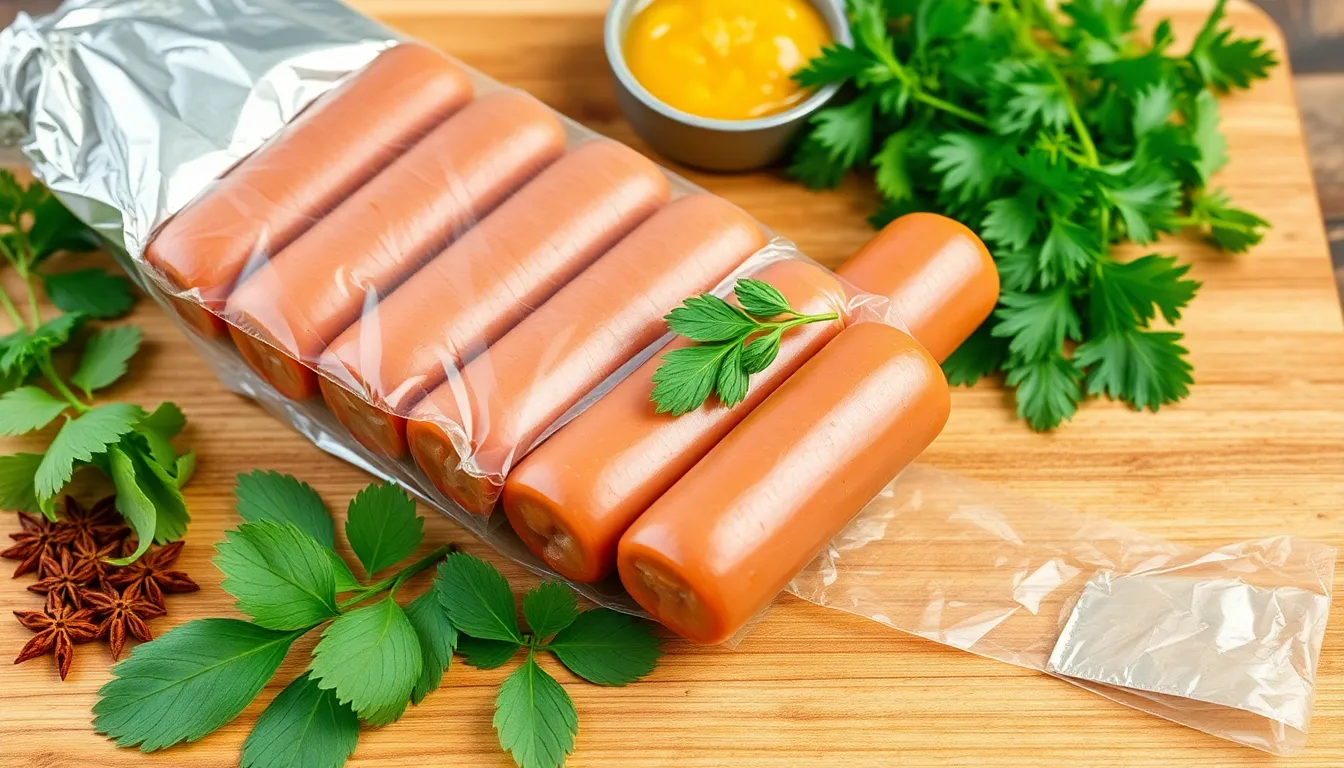
Proper storage of your homemade Thai sausages ensures you can enjoy their authentic flavors for days or even months to come. Follow these guidelines to maintain freshness and quality.
Refrigerating Fresh Thai Sausages
- Allow cooked sausages to cool completely to room temperature before refrigerating
- Store in an airtight container to prevent drying out
- Consume refrigerated cooked Thai sausages within 4-5 days
- For uncooked sausages keep them refrigerated for only 1-2 days
- If you’ve stuffed sausages into casings pat them dry and place on an uncovered tray in the refrigerator overnight to help the casing dry slightly which improves texture
Freezing for Long-Term Storage
- Wrap individual cooked sausages in cling film or aluminum foil before placing in freezer bags
- For uncooked sausages freeze them spread out on a baking sheet first then transfer to a vacuum-sealed container for best results
- Uncooked Thai sausages can be frozen for up to 2 months
- For extended freezer storage (6-12 months) vacuum sealing is recommended
- Cooked sausages remain safe and delicious in the freezer for up to 30 days
- Label containers with the date to track freshness
Thawing and Reheating
- Thaw frozen sausages overnight in the refrigerator for best results
- Never thaw at room temperature as this can promote bacterial growth
- Reheat Thai sausages on a grill or in a pan over medium heat until sizzling and heated through
- When reheating ensure the internal temperature reaches at least 160°F (71°C) for food safety
- To prevent casings from bursting when reheating pre-steam or briefly boil sausages before frying or grilling
Tips for Preserving Flavor
- If you’re making fermented Thai sausages like Sai Krok Isan they can be stored in the refrigerator for up to 1 week after fermentation
- Fresh sausage casings can be packed in salt and stored in the refrigerator for up to a year
- Freeze any portion of sausage you won’t cook within 2-3 days to maintain optimal freshness
- Different cooking methods when reheating include pan frying shallow frying baking air frying or grilling depending on your preference
With these storage techniques you can make a large batch of Thai sausages and enjoy them over time without sacrificing their distinctive flavor profile and texture.
Make-Ahead Instructions

Thai sausages like Sai Ua benefit significantly from advance preparation allowing flavors to develop and saving you time when serving. Here’s how to prepare your Thai sausages ahead of time for maximum flavor and convenience:
Preparing the Mixture
- For best flavor development mix your pork and aromatic paste up to 24 hours before cooking. This rest period in the refrigerator allows the herbs and spices to fully infuse the meat resulting in more complex flavors.
- Store the prepared sausage mixture in an airtight container in the coldest part of your refrigerator keeping it at or below 40°F (4°C).
- If you’re making a large batch divide the mixture into portions you’ll use within 1-2 days to maintain freshness.
Forming Sausages in Advance
When using casings:
- Stuff casings with the mixture up to 48 hours before cooking.
- Hang stuffed sausages uncovered in the refrigerator for at least 2 hours to develop a slightly dry exterior which improves browning.
- Keep formed sausages on a rack or plate lined with paper towels to absorb excess moisture.
For patties:
- Form patties and separate layers with parchment paper in an airtight container.
- Refrigerate for up to 2 days before cooking.
- Allow patties to sit at room temperature for 15 minutes before cooking for more even heat distribution.
Partial Cooking Method
For large gatherings you can streamline service by:
- Partially cooking sausages by steaming for 6-10 minutes until they reach 145°F (63°C) internal temperature.
- Cooling quickly then refrigerating for up to 3 days.
- Finishing on the grill or in a pan just before serving to achieve proper caramelization and full doneness at 165°F (74°C).
Make-Ahead Accompaniments
Prepare these components in advance to complete your meal:
- Thai chili dipping sauce can be made up to 5 days ahead and stored refrigerated in an airtight container.
- Pre-cut vegetable accompaniments like cabbage slices cucumber spears and fresh herbs the morning of serving.
- Cook sticky rice up to 24 hours ahead and reheat gently before serving.
Following these make-ahead instructions allows you to enjoy authentic Thai sausage even on busy weeknights without sacrificing flavor or freshness. The prepared components come together quickly while maintaining the complex flavor profile that makes Sai Ua so special.
Traditional Accompaniments

No Thai sausage experience is complete without the perfect accompaniments that balance and enhance its bold flavors. These traditional sides have been paired with Sai Ua for generations and create the authentic Thai eating experience you’re looking for.
Sticky Rice
Sticky rice (khao niew) is the quintessential companion to Thai sausage. This glutinous rice has a chewy texture and mild flavor that perfectly balances the spicy richness of Sai Ua.
- Serve in small woven bamboo baskets for authenticity
- Roll into small balls with your fingers to scoop up pieces of sausage
- The starchy quality helps temper the heat of the sausage
Fresh Vegetables and Herbs
Raw vegetables provide a refreshing crunch that contrasts beautifully with the savory sausage:
- Cucumber slices: Their cool crispness cuts through the richness
- Cabbage wedges: Offers a mild crunch to complement the bold sausage flavors
- Thai long beans: Traditional and slightly sweet
- Fresh herbs: Cilantro sprigs mint leaves and Thai basil add aromatic freshness
Dipping Sauces
A proper Thai sausage meal includes at least one vibrant dipping sauce:
- Nam Jim Jaew: A northeastern-style dipping sauce combining lime juice fish sauce toasted rice powder and chilies
- Nam Prik Noom: Roasted green chili dip popular in northern Thailand
- Simple Lime Sauce: Mix 2 tbsp lime juice 2 tbsp fish sauce 1 tsp sugar minced garlic and sliced Thai chilies
Thai Sausage Salad (Yum Goon Chiang)
Transform your Thai sausage into a complete dish by creating a flavorful salad:
- Slice cooked sausage into thin rounds
- Toss with thinly sliced shallots cilantro sprigs and fresh chilies
- Dress with fish sauce and lime juice
- Serve atop rice or alongside rice soup
Additional Side Dishes
Round out your Thai sausage feast with these complementary dishes:
- Som Tam (green papaya salad): Its tangy spicy flavor profile pairs perfectly with sausage
- Pickled vegetables: Add a sour contrast that brightens each bite
- Roasted sweet potatoes: Their sweetness balances the savory sausage
- Thai omelets: A protein-rich side that soaks up the flavors of the meal
When serving Thai sausage with these traditional accompaniments you’ll create a balanced meal that showcases the complex flavors and textures that make Thai cuisine so beloved worldwide.
Conclusion
Crafting your own Thai sausage at home transforms an exotic street food into a personal culinary achievement. With simple ingredients and a bit of patience you’ll master the aromatic blend of herbs and spices that makes Sai Ua so beloved across Thailand.
Whether you opt for traditional casings or convenient patties remember that the charm of this dish lies in its versatility. Enjoy your homemade creation with sticky rice dipping sauces and fresh vegetables for an authentic experience or incorporate it into fusion dishes for a modern twist.
The effort you put into making Thai sausage pays off wonderfully in flavor and satisfaction. Plus with proper storage techniques you can enjoy your delicious creation for weeks to come making it both a weekend project and a convenient weeknight meal option.
Frequently Asked Questions
What is Sai Ua?
Sai Ua is a Northern Thai sausage known for its vibrant flavors. It’s made with a blend of ground pork and aromatic ingredients including kaffir lime leaves, lemongrass, chili, garlic, and ginger. This fresh sausage is herb-rich and stands as one of Thailand’s most beloved street foods, recognizable by its distinctive flavor profile and bright color from turmeric and other spices.
How is Sai Ua different from other Thai sausages?
Sai Ua is a fresh herb-rich sausage from Northern Thailand, while Sai Krok Isan from Northeastern Thailand is fermented, combining pork and rice for a tangy flavor. Sai Ua features aromatic ingredients like lemongrass, kaffir lime leaves, and galangal, giving it a complex, spicy profile. Sai Krok Isan undergoes fermentation, developing probiotic benefits and a distinctive sour taste.
What ingredients do I need to make Sai Ua at home?
To make authentic Sai Ua, you’ll need ground pork (preferably with some fat), kaffir lime leaves, lemongrass, galangal, turmeric, shallots, garlic, chili, and seasonings like fish sauce and salt. For the casing, you can use traditional pork intestines or make skinless patties as an alternative. The aromatic herbs and spices are essential for the sausage’s distinctive flavor.
Do I need special equipment to make Thai sausages?
While specialized equipment like a meat grinder and sausage stuffer yields the most authentic results, you can make delicious Sai Ua with basic kitchen tools. Essential equipment includes a kitchen scale for proper proportions, a mortar and pestle for grinding herbs, and cooking equipment like a broiler grill or frying pan. For beginners, making skinless patties is a great alternative.
What’s the best way to cook Sai Ua?
Grilling is the traditional and preferred method for cooking Sai Ua, as it enhances the aromatic flavors and creates a slightly charred exterior. You can also pan-fry the sausages over medium heat until thoroughly cooked, turning occasionally to ensure even browning. For skinless versions, form the mixture into patties and pan-fry them. Cook until the internal temperature reaches 160°F (71°C).
What should I serve with Sai Ua?
Serve Sai Ua with sticky rice and fresh vegetables like cucumber, cabbage, and herbs to balance the sausage’s bold flavors. Traditional dipping sauces such as Nam Jim Jaew (tamarind-chili sauce) or a simple lime sauce enhance the experience. For a complete Northern Thai meal, include dishes like som tam (papaya salad) and laab (meat salad) alongside your sausages.
Can I make Sai Ua ahead of time?
Yes, Sai Ua can be prepared ahead of time, which actually enhances its flavor. You can mix the sausage mixture up to 24 hours in advance and refrigerate it, allowing the aromatics to fully infuse. You can also form sausages or patties ahead of time and refrigerate them covered until ready to cook. For large gatherings, partially cook them in advance and finish just before serving.
How should I store homemade Thai sausages?
Store cooked Sai Ua in an airtight container in the refrigerator for up to 3-4 days. Uncooked sausages can be refrigerated for 1-2 days. For longer storage, freeze uncooked sausages in a single layer, then transfer to freezer bags where they’ll keep for up to 3 months. Thaw frozen sausages in the refrigerator overnight before cooking for best results.
What makes Sai Ua so popular in Thailand?
Sai Ua’s popularity stems from its vibrant, complex flavor profile that perfectly embodies Thai cuisine’s balance of spicy, aromatic, and savory elements. The long lines at Sai Ua stalls across Thailand testify to its beloved status. Its versatility in traditional meals and modern fusion dishes, along with the communal aspect of sharing this street food, contributes to its enduring popularity.
Is it difficult to make Sai Ua at home?
While making Sai Ua requires some effort, particularly in preparing the aromatic ingredients and stuffing casings, it’s absolutely achievable for home cooks. The process can be simplified by making skinless patties instead of stuffed sausages. Though time-consuming, the rewards are significant—authentic Thai flavors that far surpass store-bought versions, plus the satisfaction of creating this beloved dish yourself.
